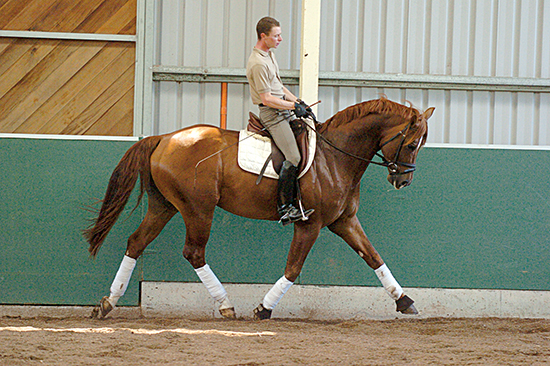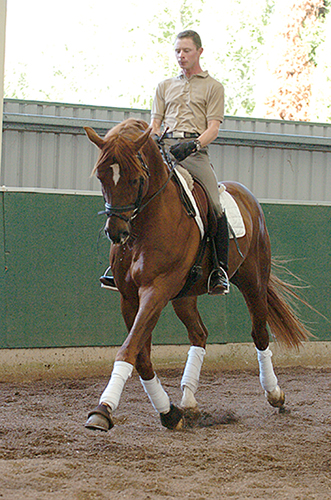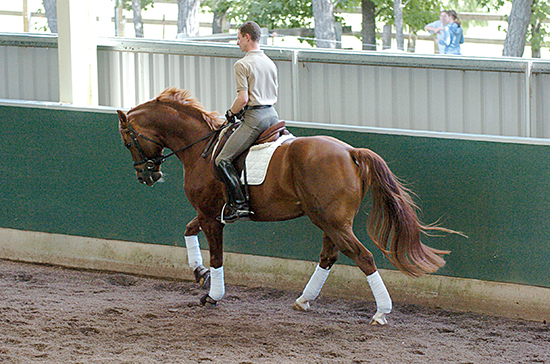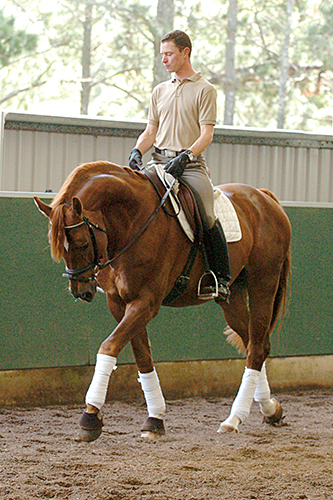 Story by Chris Hector and Photos by Roz Neave
Story by Chris Hector and Photos by Roz Neave
But really there is nothing ‘medium’ about this horse – he is exceptional. Nicholas is lucky enough to be riding Ferro Rocher, a seven year old stallion, by Florestan out of a mare by Weltmeyer. And yes, that is exactly the same cross that produced World Champion Florencio.
Ferro Rocher was a champion at Dressage with the Stars, a couple of years back but has been out for 18 months with an injury and is only just now coming back into work.
The combination of Nicholas and Ferro has just clicked, and the horse is looking truly international.
Nicholas has always been one of our better riders, but the time spent in Germany has seen a new polish and assurance, as you watch the two work, you start to dare to hope that one day this pair can be out there representing Australia!
But there is some way to go yet, as Nick stresses, with seven year olds, you play a waiting game…
“It’s where they are no longer in the young horse classes and you are looking towards FEI, so it is an in between phase. This horse has had some time off as well, so I am building up its fitness. I want to keep the horse happy in his work, build him on, and still keep him sound at the same time. That’s a real balance.”
So what were you doing in this workout?
“First I wanted to get him loose throughout his whole body. When I first started riding him he was very tight in his body because he hadn’t been worked in a dressage way for a couple of years. It’s not a completely natural way for them to travel, they don’t move like dressage horses in the paddock all of the time, despite what people say. Basically I wanted him loose from head to toe, listening to me, and happy with the work. Really sharp off the aids still, I don’t want to ask and ask and ask, I want a reaction straight away.”
I thought that was interesting that when he was being a bit lazy, you gave him one decent whack and then left him alone – rather than the nag nag nag…
“I think one good whack is better than five kicks. I think you can be as tough as you like as long as you are really nice when you get the reaction you want, and as long as it is tough in a fair way. He is a bit lazy, and you do have to motivate him, but once you get him going you can be quiet and leave him alone.”
When a horse has got a really wonderful natural walk, like that, what do you do to protect it?
“Leave it alone. I have to be honest with myself and check if he is really on the aids or not, can I ride a walk / halt transition? Or a walk / trot and still keep him in completely the same frame. But I try not to do so much with the walk, try not to get it too quick or too slow. Think of the rhythm all the time, and try not to work too much with it, it is already good.”
And in the trot, you were first trying to get it expansive? Loose and free?
“When I first get on, he is allowed to trot like a pony. He lives in a paddock, but when we start in the school, he is still getting loose – and I know when I get out of bed in the morning, I feel pretty ordinary. I like to let him trot, get the neck down and the nose down and out, and loose through the body – he has got to take the rein gently away from my hand, and be straight, but still reactive to the leg. He needs time to warm up before he can start to trot really flash.”
He’s got a very expressive canter?
“The canter is super. It’s easy to ride, but it is easy to be fooled because he finds it so easy to be round. He needs to be round not just in the neck but in the back as well. He wants to collect in the canter a lot, and you have to watch that the rhythm in the canter doesn’t get too slow. Keep it a little bit quicker with the hind leg – and he stays straight. He would do pirouettes whenever you want them, but he has got to be straight and a little bit quicker with the hind leg. The canter is pretty easy for him, the changes are easy also.”
Easier on one side?
“More expressive on one side… and which side changes all the time. The left change was very hard to get in the beginning because he wasn’t straight enough. Some days I can ride twos and ones, and some days I just ride one single change, it depends on if he is going well enough, if he is straight enough and active enough and motivated.”
Is it hard when you’ve got a horse that is nibbling at the edge of FEI level, to back off a little?
“Sure it is. I have to continually tell myself to stay honest with the basics. I can make a trot seriously fancy, and I can get him to do all the movements really easily, but I have to stay honest with myself and say ‘can I ride a perfect trot / walk transition, or a trot / canter transition and is he genuinely on the bit and straight?’ It is so tempting because he finds the hard work so easy, it’s tempting to ride the movements especially when you have a lot of clients around and people looking, but you have to stay honest with yourself and ask is the horse genuinely on the aids or not. I have to keep reminding myself of that all the time, and that is hard to do.”
There is a really sensational passage lurking around there…
“There is but I’m not really supposed to touch that one yet. I do occasionally, normally when I’ve got some supervision there. The piaffe is better and he wants to do the piaffe so I don’t do it too much. That’s nice to know that I’ve got a horse that wants to do piaffe, passage and changes, but I’ve got to just keep him sound and on the bit until he is ready for that work.”
But the work you are doing is very much the sort of work that you see in Martina Hannöver’s arena in Germany… no magic tricks or gimmicks, just clean athletic work?
“I hope so. I’m sort of at the position where I would like to find some magic words, but the truth is that it is just the same thing over and over – BASIC WORK. And it is basic work that is seriously hard. I’d love to find some magic secrets, but unfortunately there are none. I said to someone the other day, ‘I’m tired of dealing with the basics, I want some magic, and I want tricks, but it doesn’t work’. It never works.”
And your career – you started as an eventer?
“My mother and my grandfather trained racehorses so I always had ponies. I think I was given a pony when I was three. I started pony club eventing. I was living in a little town which wasn’t a very horsey area, so when I was 17, I left school and moved up to Heath and Rozzie Ryan’s. That was a serious eye-opener. I learnt to work really really hard, I learnt what eventing was about and what being a professional rider was about, and how difficult it is.”
“I did my time there – I was with Heath for four years. In 2002 I groomed for Heath at the WEG in Spain, when he had Stirling Stilton, and I was with him for a while in Germany before that. We were based at Grohnwoldhof and Heath also rode at Martina Hannöver’s. At Martina’s I saw dressage in its purest form, the most amazing dressage – and that’s when I started to think, hang on a minute, I am pretty tired of falling off, tired of getting these horses up the eventing rungs, and then breaking them. Deep down I knew I was a closet dressage rider!”
“I did one more Three Day Event after I came back from Spain, and that’s when I decided to go to dressage. I stopped working for Heath but still based at the Centre, did a year on my own. The first couple of months were tough, building up clientele. I rode at the racetrack for a little while – hated it, feared for my life every day – and then I rode for a dressage stud, and that didn’t work out. Eventually Bonnie Holstein took me under her wing, and I got the ride on two of her horses. Sierra Bravo, who I was lucky enough to do a whole season of Grand Prix on, and a super young horse as well. I also managed to score the ride on a small tour horse, so I had a big and a small tour ride in 2003.”
“At the end of 2003 I went to Martina Hannöver in Germany. I was stuck in the work in Australia. I knew I was missing something. I knew I didn’t sit well enough to let the horses go well enough. I watched Boyd Martin when he came back from Martina’s, and he was sitting beautifully! I was jealous. I thought: ‘I can’t have Boyd sitting better than me!!! He’s just a larrikin’. I’d met Martina when I went over with Heath and I knew how amazing she was. I was getting a little bit comfortable at the Centre, and I think you have to keep putting yourself out of the comfort zone to get better. That’s why I went to Martina’s.”
“I knew what to expect having been there before but it was seriously hard. When I left Australia I was a pretty good rider and had my own stable, then you start at the bottom again.”
Under all those girls…
“All those girls. I was the only guy there but it didn’t turn out too bad in the end. It was tricky in the beginning, but I have a lot of respect for Martina, and I think by the end she had some respect for me too. I got good rides in the end, and I learnt so much. In my heart I sometimes think I need to be there and other times I think I am happy to have done my time there. I still think I definitely need to go back.”
What did you learn, position?
“Martina definitely worked on my seat and that got a lot better but I remember she said to me not long before I left, ‘I’m glad we didn’t just fix your position, I’m happy that you started to develop a good feel, not just on the younger horses but also on the older horses’ – it wasn’t just my position, I think I developed a more true understanding of the half halt, and that is pretty necessary. The main thing I learnt about the half halt over there, is getting the horse travelling on its own and keeping the horse happy in the work. You can make the horse do the work, but you can’t really make the horse do it – it has got to want to do the work as well. Keeping the horse happy in its brain is important.”
Nice to come back to Australia and get the ride on a Florestan / Weltmeyer stallion?
“That was lucky, really really lucky. I’m lucky that I am a short person and it is not a very big stallion, it makes a nice picture. I’d probably be back in Germany if I didn’t have the ride on that stallion.”
That would be a fancy horse in Germany…
“Anywhere. I think he is as good as anything I’ve ridden and I’ve ridden some pretty good horses.”
You are confident he will go Grand Prix?
“The horse has got the ability, there are just so many factors to take into account. Keeping the horse sound and sane, me staying on track in my own mind – also a lot of luck, but I am going to give myself and the horse every opportunity to do it.”
It’s a nice working environment here – you’ve even got an owner who is also a judge and can help on the ground, and a bit of friendly rivalry with Brett Parbery. I think that is what Australians miss out on – it is very hard to keep the concentration level up when you are riding on your own?
“Exactly, that’s why Brett and I set up here. We both realised over in Germany that you never ride alone, there is always a pair of critical eyes watching over you. We both knew that to be nearly as good as we can be, we needed someone else in the arena. We don’t talk to each other every day about riding, but just having someone in the arena, definitely makes you ride better. If he is riding well, well I want to ride better – and if I am riding well, he wants to be better. It’s a friendly competition between us. And having Jenny (Rapson – Ferro Rocher’s owner) around helps, we have some very good owners here and a great atmosphere. We are all seriously competition oriented but we still want to ride the horses well every day. We are working towards winning competitions, but we still want to keep the horses happy as well.”
Nicholas is certain he can go to the top with Ferro Rocher:
“The movements are not a problem, it’s just keeping him sharp and motivated throughout the whole test. If I don’t have him sharp before the test, I need oxygen before I finish – because he is happy to eat grass all day rather than work too hard. I can miss a change in a test if I don’t set him up, or I can lose the rhythm in the lateral work in the trot. They are the movements I need to watch but they generally come down to – is he sharp enough?”
“He has got a serious presence, the collective marks should all be really good, it is just a horse of quality, and quality should win overall, shouldn’t it?”
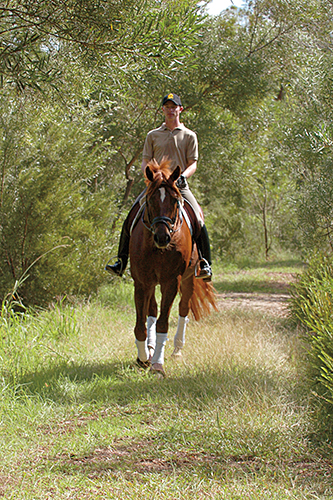 And after the work in the arena, a nice relaxing walk outside…
And after the work in the arena, a nice relaxing walk outside…




